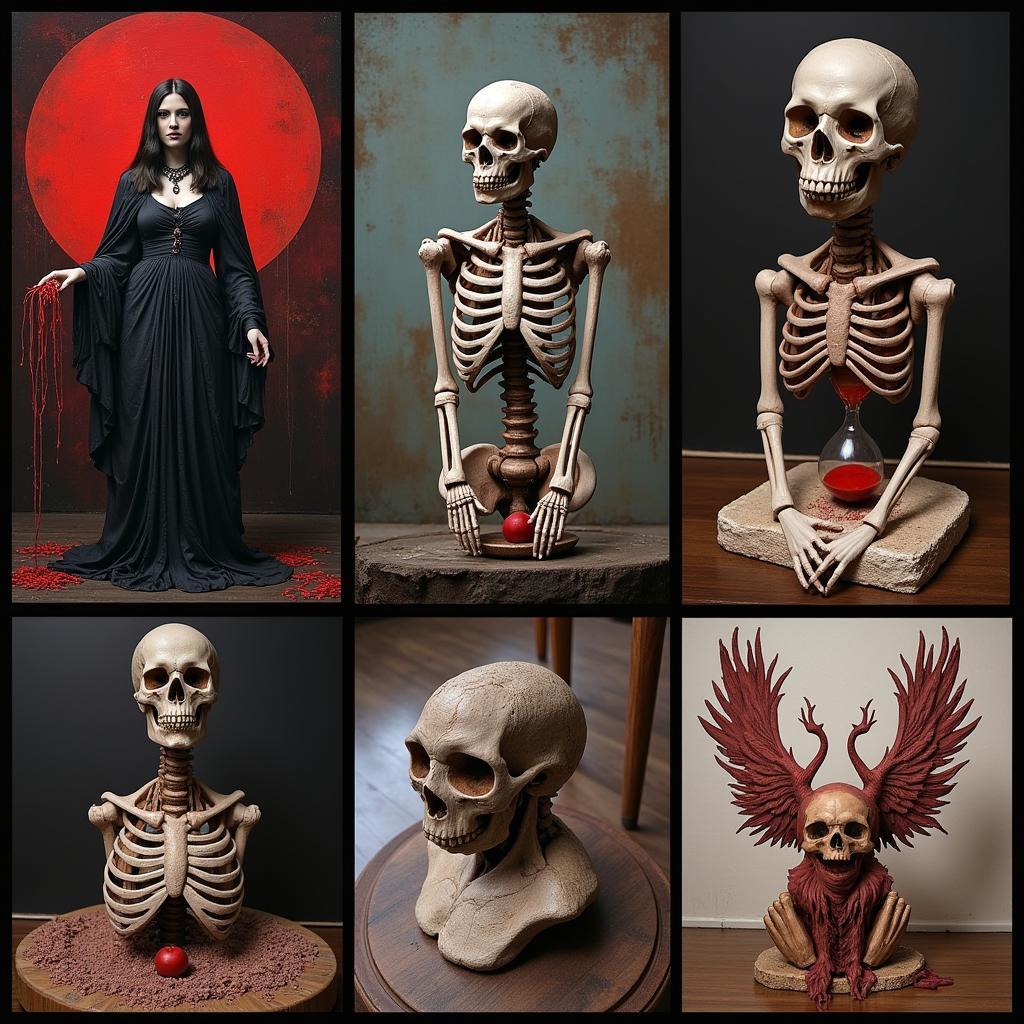Delving into the Darkness: Understanding Dark Death Art
Dark Death Art, a genre often shrouded in taboo and misunderstanding, explores the intricate relationship between humanity and mortality. Through various mediums, it visually confronts the inevitability of death, prompting viewers to contemplate their own existence and the fragility of life. This exploration of the macabre, while unsettling for some, offers a unique lens through which we can examine our fears, anxieties, and ultimately, our acceptance of the human condition.
Unmasking the Meaning: What is Dark Death Art?
Dark death art isn’t about glorifying death but rather initiating a conversation about it. It delves into the darker aspects of human existence, often incorporating themes of decay, suffering, and the afterlife. This exploration can manifest in various forms, including but not limited to:
- Gothic Art: Characterized by its focus on architecture, death, and the grotesque, Gothic art often portrays macabre imagery and supernatural elements.
- Memento Mori: Latin for “remember you must die,” memento mori artworks serve as stark reminders of life’s ephemerality, often featuring skulls, hourglasses, and other symbols of mortality.
- Flesh Art: Pushing boundaries, flesh art utilizes organic materials, sometimes even human remains, to create visceral and thought-provoking pieces.
- Surrealism and Symbolism: By tapping into the subconscious, these movements often employ morbid imagery and dreamlike sequences to explore the themes of death and the unknown.
 Dark Death Art Examples
Dark Death Art Examples
A Historical Perspective: Tracing the Roots of Death in Art
The depiction of death in art is not a new phenomenon. From ancient Egyptian funerary art to medieval danse macabre, humanity has long grappled with mortality through creative expression.
- Ancient Civilizations: Egyptian art, with its elaborate tombs and mummification practices, provides a glimpse into their beliefs about the afterlife. Similarly, Greek mythology frequently featured Hades, the god of the underworld.
- The Black Death: The devastating plague of the 14th century left an undeniable mark on art, leading to a surge in imagery depicting skeletons, decaying corpses, and the Grim Reaper.
- The Victorian Era: Obsessed with mourning rituals, the Victorians developed a unique visual language surrounding death, evident in their post-mortem photography and elaborate funerary practices.
The Appeal of Darkness: Why are We Drawn to Morbid Art?
The allure of dark death art lies in its ability to confront us with the uncomfortable realities we often try to avoid. It forces us to acknowledge our mortality, prompting introspection and existential questioning.
- Catharsis and Confrontation: Dark death art can serve as a form of catharsis, allowing viewers to process their fears and anxieties related to death and loss.
- Philosophical Exploration: By engaging with themes of mortality, these artworks encourage philosophical reflection on the meaning of life and our place in the universe.
- Aesthetic Appreciation: Beyond the macabre subject matter, dark death art often showcases exceptional skill, detail, and craftsmanship, captivating viewers with its technical brilliance.
Dark Death Art Today: Contemporary Expressions of Mortality
The digital age has ushered in new forms and interpretations of dark death art. Artists now utilize technology to push creative boundaries, exploring the themes of death and decay through digital painting, glitch art, bio art, and more. This contemporary approach ensures the genre remains relevant and continues to provoke dialogue around our inevitable end.
Conclusion
Dark death art, far from being gratuitous or morbid, offers a powerful platform for exploring the human condition. It reminds us of life’s preciousness, encourages us to confront our fears, and inspires meaningful dialogue about death and the legacy we leave behind. While the genre may not be for everyone, its enduring presence throughout history is a testament to humanity’s ongoing fascination with mortality and the mysteries that lie beyond.
FAQs
1. Is dark death art only about death?
While death is a central theme, dark death art often explores broader concepts like fear, anxiety, the afterlife, and the human condition.
2. Is dark death art intended to be disturbing?
The intention of dark death art is not necessarily to disturb but rather to provoke thought and conversation around often-avoided subjects.
3. What are some famous artists associated with dark death art?
Throughout history, many artists have explored death in their work, including:
- Hieronymus Bosch: Known for his fantastical and often grotesque imagery depicting sin and the afterlife.
- Francisco Goya: His series “The Disasters of War” and “The Black Paintings” offer chilling depictions of violence, suffering, and death.
- Frida Kahlo: Her self-portraits often explored themes of pain, mortality, and the fragility of the body.
4. Where can I learn more about dark death art?
The johns creek arts center offers a diverse range of resources and exhibitions showcasing both historical and contemporary art.
5. Is dark death art becoming more popular?
With the rise of the digital age and a renewed interest in the macabre, dark death art continues to evolve and find new audiences.
You Might Also Be Interested In:
- The Psychology of Morbid Curiosity: Explore the reasons behind our fascination with death and the macabre.
- Art as Therapy: Discover how art can be a powerful tool for processing grief, trauma, and existential anxieties.
Need Help?
Contact us 24/7. Phone Number: 02462573573, Email: danteum@gmail.com Or visit us at: Savico Megamall, 7-9 Đ. Nguyễn Văn Linh, Gia Thụy, Long Biên, Hà Nội 10000, Việt Nam.

